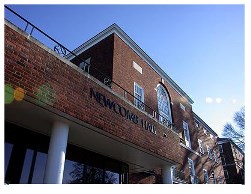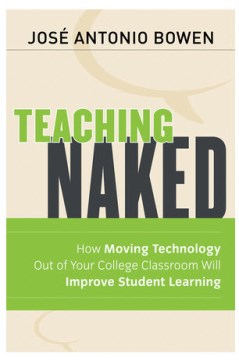 Yesterday, Joyce Kincannon and I traveled up the road to Charlottesville and the University of Virginia for their second annual Innovation in Pedagogy Summit. We spend a good deal of our mental energy in our learning center focused on innovation in teaching and learning, and so this was an opportunity to see now another university might approach both the topic and the process of faculty development around the topic. This full day event was a collaboration between the UVa College and Graduate School of Arts & Sciences, the Teaching Resource Center, the Office of the Executive Vice President & Provost, and the 4-VA Collaborative, and we appreciated the invite!
Yesterday, Joyce Kincannon and I traveled up the road to Charlottesville and the University of Virginia for their second annual Innovation in Pedagogy Summit. We spend a good deal of our mental energy in our learning center focused on innovation in teaching and learning, and so this was an opportunity to see now another university might approach both the topic and the process of faculty development around the topic. This full day event was a collaboration between the UVa College and Graduate School of Arts & Sciences, the Teaching Resource Center, the Office of the Executive Vice President & Provost, and the 4-VA Collaborative, and we appreciated the invite!
During the morning, six faculty shared their innovations in teaching with their peers, while the afternoon was devoted to José Bowen, author of Teaching Naked.
In many ways, what we saw from faculty were concepts we have advocated for the past few years…yet these concepts seemed new to many in the room. We saw Ran Zhao’s Elementary Chinese course that incorporated student-created videos as assignments, Claudrena Harold’s African American studies course which scaffolded mini-assignments before sending student groups out to interview and archive alumni perspectives, and Brian Helmke who welcomed student use of Google before and in his lectures. Mark White discussed the use of spoken stories to motivate students, Stephanie Van Hover used Structured Academic Controversy to encourage the use of multiple perspectives in class discussions, and Dave Kittlesen illustrated how low-tech paper handouts can help students conceptualize difficult genetic concepts.
While the focus for the morning was “engaging students”, I was struck by how few faculty in the room had devices to connect to the internet during these morning presentations. It appeared that digital engagement was lacking. There was no established hashtag for the summit, and little advocacy was apparent for digital engagement – other than demonstrating how a few faculty used digital connections with their students. It hit me as an interesting missing element at an “innovation” summit…or else it highlighted that the web is so much a part of me that I am surprised when it is not a part of my colleagues.
During lunch, each table had a “theme” assigned. I sat with folks who wanted to discuss “collaborative spaces” as a new breed of classroom. I shared information about our Learning Studio – carefully designed by my colleague Jeff Nugent – which seemed in line with some proposals UVa is considering. Our Learning Studio is a state-of-the-art classroom that has been designed to support VCU faculty members and students in their exploration and study of new learning spaces. Located in the Academic Learning Commons, the Learning Studio contains a wide array of technologies and furniture that combine to provide unique opportunities to enhance teaching and learning. For larger classrooms, José Bowen shared a view of a traditional tiered large classroom in which all desks had been removed and replaced with “Learn2″ chairs on wheels to facilitate small group work. This also aligned with changes being considered at UVa. As the welcomed outsider, it was interesting to hear faculty discuss new ways of conceptualizing class spaces with no clear “front of the room.”
 For me, the highlight of the day was José Bowen‘s afternoon presentation. He is the author of Teaching Naked: How Moving Technology Out of the Classroom Will Improve Student Learning. I was expecting a “close your laptop” focus, but what I heard was the exact opposite. I subsequently read a review by James Lang that summed José’s premise up well:
For me, the highlight of the day was José Bowen‘s afternoon presentation. He is the author of Teaching Naked: How Moving Technology Out of the Classroom Will Improve Student Learning. I was expecting a “close your laptop” focus, but what I heard was the exact opposite. I subsequently read a review by James Lang that summed José’s premise up well:
“The book’s title make Bowen sound like a cranky Luddite, a chalk-and-talk professor who wants the kids to put away their smart phones and get their noses back into the books, and then sit up straight and listen to the professor in class. Nothing could be further from the truth. Bowen actually celebrates the ability of technology to move much of our traditional teaching work out of the classroom, and wholeheartedly embraces a wide range of educational technologies as capable of doing the work of teaching content more effectively than professors.
The flip side to that argument, though, is that once we actually get students to interact with those technologies outside of the classroom, we should be spending our time in the classroom engaging in more frequent face-to-face interaction with them. Bowen sees the classroom as the space where we prove our value as educators to students, and argues that we should not be wasting that valuable space by lecturing students on basic content. Let them gain first exposure to that content through podcasts, videos, e-mails, Google searches, and so on. Then let them deepen the exposure in the classroom through human interaction.”
- A digital entry point as first exposure to a topic
- By email, Facebook, or other social media
- First exposure to the topic through a pre-assignment
- Short and focused
- Find open content (or let students find it)
- Use summary sites like Wikipedia
- A short writing (a paragraph on index cards…or Evernote) to reflect before class
- Start with what matters to students…then connect to what matters to you
- Ask the question not in the summary site
- Interpretation…not summarize
- A low stakes exam on entering the classroom
- Use higher order thinking skills from Blooms
- A challenging class – not lecture
- Alter conditions and have students reanalyze
- Complicate and reframe problems
- Have students work on problem solving and “learning to learn”
- Keep it relevant and real world
- He suggested using techniques from Stephen Brookfield
- Digital communication after class to reinforce
- Cognitive wrappers for self-regulation of students
- Self-reflection by students on time they spent preparing, process they used, and what they might do different next time
José’s focus is that the role of faculty no longer involves providing scarce content. Technology provides richer content than any of us could provide. Instead, our role is to prepare students to face the unknown…to be critical consumers of this ubiquitous content. Students pay a lot for class time…and they should get more than a lecture. New technology means that we can focus with our students on thinking and integration.
This aligned nicely with a post this morning by Debbie Morrison – “A Not-So-New Recipe for “A New Culture of Learning”“. Debbie was reviewing a book by Douglas Thomas and John Seely Brown entitled A New Culture of Learning. Thomas and Brown suggests that this:
“…new culture of learning actually comprises two elements. The first is massive information network that provides almost unlimited access and resources to learn about anything. The second is bounded and structured environment that allows unlimited agency to build and experiment with things within those boundaries”.
In this new culture, questions are more important than answers, and students learn through inquiry rather than instruction. Debbie suggests that this message is not new…but will be new to many faculty. I would agree. Our work with our GRAD-602 students reinforced that their concept of teaching is rooted in older models…not this new reality. José suggested to me that I remind our GRAD-602 students that they are the outliers – successful in the game of school and looking to continue that game. That no longer matches “the real world” … and José passionately believes we need to help students prepare for this real world – a world of unknowns and a world where unlearning and relearning will be key skills.
So fun day at UVa and a chance to add José to my PLN.


Britt,
I appreciate the sharing of your experience of the Innovation in Pedagogy Summit. How interesting to read about the lack of digital engagement of conference attendees, yet the topic is innovation in teaching! Though it’s not surprising. There is so much opportunity for discussion about and advancement of new ideas with regards to different methods of teaching.
I’ve added the book “Teaching Naked” to my reading list based upon your recommendations. Thanks for this. I look forward to reading it!
Thanks also for linking to my blog post about “A New Culture of Learning”.